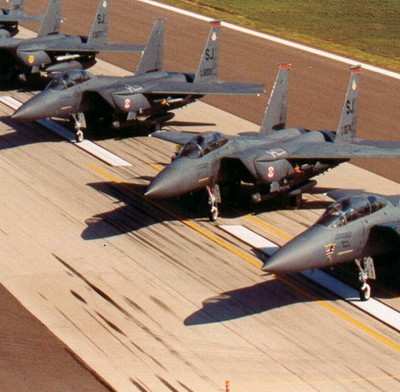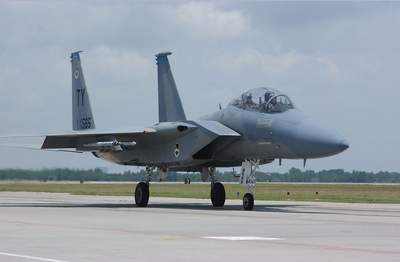Approximately 700 Aircraft Grounded
What was originally a "precautionary measure" has evolved into
something on a far greater scale. The US Air Force has suspended
all normally-scheduled operations involving F-15 Eagle fighter
jets, including planned missions in Iraq and Afghanistan. The
suspension affects roughly 700 aircraft.

As ANN reported, the USAF
suspended all non-critical F-15 operations this weekend, following
the November 2 downing of a Missouri Air National Guard F-15. Early
reports point to in-flight structural failure as the cause of that
crash; the single pilot onboard was able to eject, suffering
non-life-threatening injuries in the process.
Officials are concerned the accident points to a potential
fleetwide issue with the aging fighters. The first F-15s entered
service in the mid-1970s; the C-model aircraft involved in Friday's
accident was built in the early-1980s.
The suspension does not apply to "mission-critical" uses,
including emergency operations in Iraq and Afghanistan. Newer F-15E
Strike Eagles (shown at center) are deployed in those theaters,
while older planes are mostly flown by ANG and reserve units. The
aircraft involved in Friday's accident was operated by the 131st
Fighter Wing at Lambert Field.
Douglas Birkey, deputy director for government relations at the
Air Force Association, told The Washington Post that accident shows
pilots are at risk when flying the F-15, and in particular putting
the aging aircraft through high-speed, high-G-force maneuvers.

"Obviously that pilot in Missouri didn't get into that aircraft
thinking it would come apart on him," Birkey said. "Each day you
push out the age of the fleet, you're coming closer to a cliff.
That F-15 went off a cliff."
The Air Force has started replacement of the oldest F-15s with
F-22 Raptor fighters. To date, 97 F-22s have entered service, and
the Air Force wants more. Congress has authorized funding for 183
Raptors; the USAF wants 381.
"It does make you wonder about the stress on the airframe and
the age," said Georgia congressman Phil Gingrey, member of the
House Armed Services Committee. "But this is not just simply a
matter of flight reliability because of aging and metal fatigue,
but the fact that the F-22 is so far superior." (Gingrey's district
includes Marietta, where Lockheed Martin's primary F-22 assembly
plant is located.)

The Air Force says it is possible F-15s may be grounded for
days, or longer if officials determine all aircraft must be
inspected. Missions originally conducted with F-15s will either be
postponed, or flown with other aircraft.
"I worry about the health of our aging fleet and how sometimes
it is not well understood by those our airmen protect," said Air
Force Lt. Gen. Gary L. North, commander of US Central Command's
Combined Forces Air Component.
There have been at least three incidents involving F-15Cs this
year, including a midair collision during Red Flag 2007. The 131st
Fighter Wing lost another F-15 in May,
when a control cable failed inflight.
Lt. Gen. David Deptula, the Air Force's deputy chief of staff
for intelligence, surveillance and reconnaissance, is familiar with
possible issues involving F-15s. In 1999, Deptula experienced an
emergency situation while flying an F-15 over Iraq; it was
determined wiring had disintegrated due to age, according to the
Post.

Today, Deptula's son flies the same planes. "They have become
serious maintenance challenges as they get older, and now I'd
suggest that we may be facing a crisis," Lt. Gen. Deptula said.
 Unfortunate... ANN/SportPlane Resource Guide Adds To Cautionary Advisories
Unfortunate... ANN/SportPlane Resource Guide Adds To Cautionary Advisories ANN FAQ: Turn On Post Notifications
ANN FAQ: Turn On Post Notifications ANN's Daily Aero-Term (04.29.24): Visual Approach Slope Indicator (VASI)
ANN's Daily Aero-Term (04.29.24): Visual Approach Slope Indicator (VASI) ANN's Daily Aero-Term (04.28.24): Airport Marking Aids
ANN's Daily Aero-Term (04.28.24): Airport Marking Aids ANN's Daily Aero-Linx (04.28.24)
ANN's Daily Aero-Linx (04.28.24)






